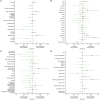Quality and quantity of serious violent suicide attempts during the COVID-19 pandemic
- PMID: 35928775
- PMCID: PMC9343723
- DOI: 10.3389/fpsyt.2022.927696
Quality and quantity of serious violent suicide attempts during the COVID-19 pandemic
Abstract
Background: While repeated shutdown and lockdown measures helped contain the spread of SARS-CoV-2 during the COVID-19 pandemic, social distancing and self-isolation negatively impacted global mental health in 2020 and 2021. Although suicide rates did reportedly not increase during the first months of the pandemic, long-term data, and data on the quality of serious violent suicide attempts (SVSAs) are not available to date.
Materials and methods: Orthopaedic trauma patient visits to the emergency department (ED), ED trauma team activations, and SVSAs were retrospectively evaluated from January 2019 until May 2021 in four Level-I Trauma Centers in Berlin, Germany. SVSAs were assessed for suicide method, injury pattern and severity, type of treatment, and length of hospital stay.
Results: Significantly fewer orthopaedic trauma patients presented to EDs during the pandemic (n = 70,271) compared to the control (n = 84,864) period (p = 0.0017). ED trauma team activation numbers remained unchanged. SVSAs (corrected for seasonality) also remained unchanged during control (n = 138) and pandemic (n = 129) periods, and no differences were observed for suicide methods, injury patterns, or length of hospital stay.
Conclusion: Our data emphasize that a previously reported rise in psychological stress during the COVID-19 pandemic does not coincide with increased SVSA rates or changes in quality of SVSAs.
Keywords: COVID-19; SARS-CoV-2; death; injury; mortality; violent suicide attempts.
Copyright © 2022 Maleitzke, Zocholl, Topp, Dimitrov-Discher, Daus, Reaux, Zocholl, Conze, Kolster, Weber, Fleckenstein, Scheutz Henriksen, Stöckle, Fuchs, Gümbel, Spranger, Ringk and Märdian.
Figures



Similar articles
-
Effect of the Coronavirus Disease 2019 Pandemic on Suicide-Related Trauma Burden at a Level 1 Trauma Center.J Emerg Trauma Shock. 2022 Apr-Jun;15(2):88-92. doi: 10.4103/jets.jets_142_21. Epub 2022 Jun 27. J Emerg Trauma Shock. 2022. PMID: 35910318 Free PMC article.
-
Impact of the COVID-19 shutdown on orthopedic trauma numbers and patterns in an academic Level I Trauma Center in Berlin, Germany.PLoS One. 2021 Feb 16;16(2):e0246956. doi: 10.1371/journal.pone.0246956. eCollection 2021. PLoS One. 2021. PMID: 33592046 Free PMC article.
-
Emergency Department Visits for Suspected Suicide Attempts Among Persons Aged 12-25 Years Before and During the COVID-19 Pandemic - United States, January 2019-May 2021.MMWR Morb Mortal Wkly Rep. 2021 Jun 18;70(24):888-894. doi: 10.15585/mmwr.mm7024e1. MMWR Morb Mortal Wkly Rep. 2021. PMID: 34138833 Free PMC article.
-
Registered psychiatric service use, self-harm and suicides of children and young people aged 0-24 before and during the COVID-19 pandemic: a systematic review.Child Adolesc Psychiatry Ment Health. 2022 Feb 25;16(1):15. doi: 10.1186/s13034-022-00452-3. Child Adolesc Psychiatry Ment Health. 2022. PMID: 35216630 Free PMC article. Review.
-
Effect of the COVID‑19 pandemic on the management and outcomes of patients with traumatic injuries (Review).Biomed Rep. 2023 Sep 5;19(4):76. doi: 10.3892/br.2023.1658. eCollection 2023 Oct. Biomed Rep. 2023. PMID: 37746590 Free PMC article. Review.
Cited by
-
Trends in medically serious suicide attempts before and after COVID-19: a four-year retrospective analysis (2018-2022).BMC Psychiatry. 2024 Nov 6;24(1):770. doi: 10.1186/s12888-024-06232-x. BMC Psychiatry. 2024. PMID: 39506706 Free PMC article.
References
LinkOut - more resources
Full Text Sources
Miscellaneous

